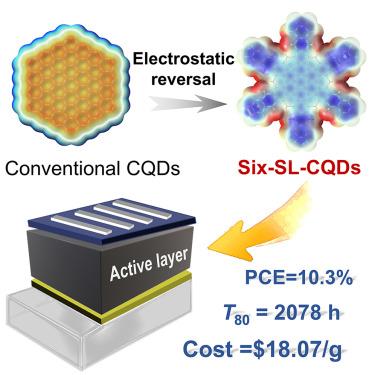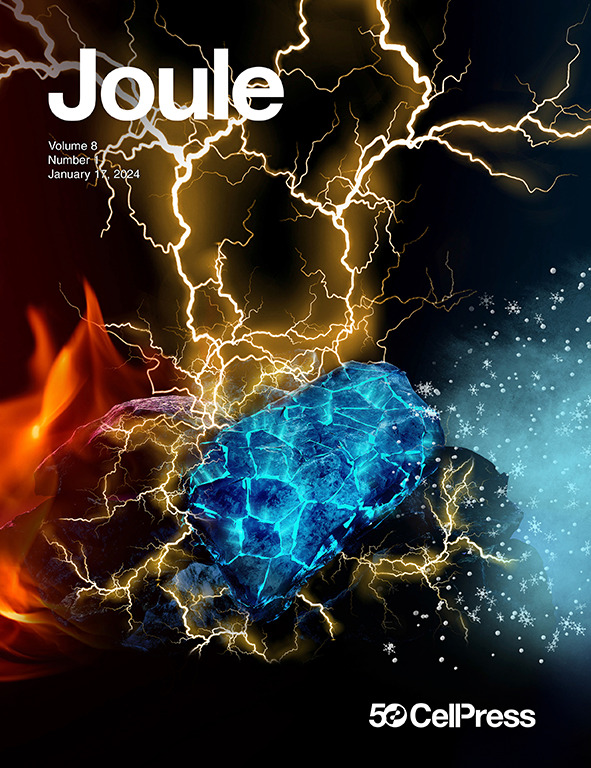六角极化雪花状碳量子点静电还原低成本高效太阳能电池
IF 35.4
1区 材料科学
Q1 CHEMISTRY, PHYSICAL
引用次数: 0
摘要
虽然有机太阳能电池(OSCs)的功率转换效率(pce)已超过20%,但由于有源层材料成本高,阻碍了其实际应用。碳量子点(CQDs)具有低成本、独特的光电性能和结构功能化等优点,是太阳能电池(SCs)的理想材料。然而,作为活动层的cqd到目前为止只有1%的pce。在这里,我们报道了一步合成具有一个碳核和六个等效极化角的雪花状CQDs (6 - sl -CQDs),其成本低至约18.07美元/g,并且具有足够的溶液可加工性。实验结果表明,所设计的结构可以逆转六个角与碳芯之间产生的静电势。6 - sl - cqds作为受体分子,构建强的给受体分子间相互作用,导致有序的结构堆叠和有效的激子解离。其最大PCE为10.3%,长期稳定,T80超过2078 h。这些发现打破了成本瓶颈,促进了碳纳米材料基SCs的实际应用。本文章由计算机程序翻译,如有差异,请以英文原文为准。


Six-angle polarized snowflake-like carbon quantum dots via electrostatic reversion for low-cost and high-efficiency solar cells
Although organic solar cells (OSCs) have power conversion efficiencies (PCEs) exceeding 20%, high material cost of active layer hinders their practical applications. Carbon quantum dots (CQDs) with low cost, unique optoelectronic properties, and structural functionalization are promising candidates for solar cells (SCs). However, CQDs as active layers so far merely had 1% PCEs. Here, we report the one-step synthesis of snowflake-like CQDs with one carbon core and six equivalent polarized angles (Six-SL-CQDs), showing cost as low as ∼$18.07/g and adequate solution processability. Experimental results reveal that the designed structure can reverse the electrostatic potential generated between six angles and carbon core. Six-SL-CQDs serve as acceptor molecules to construct strong donor-acceptor intermolecular interactions, leading to orderly structural stacking and effective exciton dissociation. SCs exhibit a maximum PCE of 10.3% and long-term stability, with T80 exceeding 2,078 h. These findings break the cost bottleneck and facilitate the practical application of carbon nanomaterial-based SCs.
求助全文
通过发布文献求助,成功后即可免费获取论文全文。
去求助
来源期刊

Joule
Energy-General Energy
CiteScore
53.10
自引率
2.00%
发文量
198
期刊介绍:
Joule is a sister journal to Cell that focuses on research, analysis, and ideas related to sustainable energy. It aims to address the global challenge of the need for more sustainable energy solutions. Joule is a forward-looking journal that bridges disciplines and scales of energy research. It connects researchers and analysts working on scientific, technical, economic, policy, and social challenges related to sustainable energy. The journal covers a wide range of energy research, from fundamental laboratory studies on energy conversion and storage to global-level analysis. Joule aims to highlight and amplify the implications, challenges, and opportunities of novel energy research for different groups in the field.
 求助内容:
求助内容: 应助结果提醒方式:
应助结果提醒方式:


